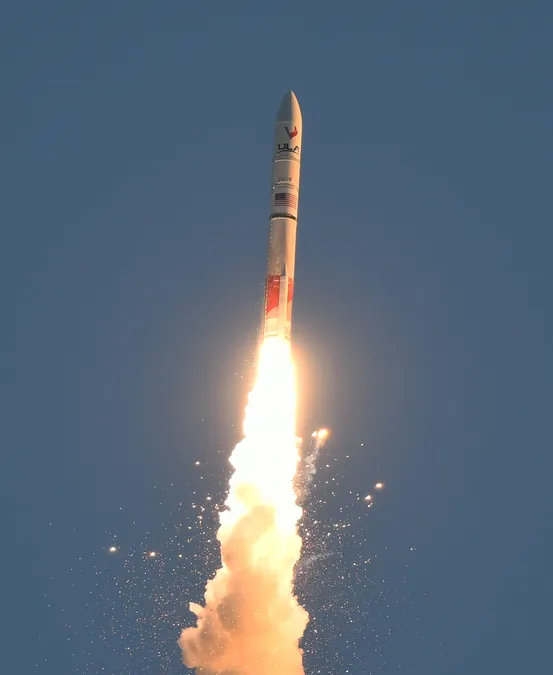
ULA's Bold Test: Vulcan Rocket Defies Odds with Booster Anomaly
2024-10-04
In a groundbreaking test flight, United Launch Alliance's (ULA) Vulcan rocket accomplished a remarkable feat on its second certification mission, referred to as Cert-2.
Launching from Cape Canaveral Space Force Station in Florida at 7:25 AM EDT on Friday, the 202-foot-tall rocket experienced an anomaly with one of its strap-on boosters shortly after liftoff, yet it still achieved its primary mission objectives.
Designed to serve both the U.S. military and Amazon's ambitious Kuiper broadband network, the Vulcan rocket is positioned as a crucial player in national security missions, aiming to begin launching military satellites in the near future. Engineers are currently diving into the details of the booster anomaly, which arose as the rocket ascended into orbit.
A Dramatic Turn
Around 37 seconds into the flight, an unexpected shower of sparks erupted from one of the solid rocket boosters produced by Northrop Grumman, causing the Vulcan to tilt slightly. Fortunately, the rocket's guidance systems quickly adjusted, and videos captured during the launch clearly showed the nozzle of the affected booster detaching and falling away safely.
"It looks dramatic, like all things on a rocket," ULA CEO Tory Bruno commented, emphasizing that no explosions transpired.
The Federal Aviation Administration (FAA), overseeing commercial rocket launches in the U.S., indicated that although they had assessed the anomaly, there was no need for an immediate investigation. This decision underscores the agency’s focus on public safety, determining that the booster issue did not pose any risks to surrounding areas.
Technical Triumph Amid Adversity
Despite experiencing "reduced, asymmetric thrust," which ULA successfully compensated for, the Vulcan rocket's BE-4 main engines—supplied by Blue Origin, the aerospace venture of Jeff Bezos—functioned flawlessly for the initial phase of the flight.
After several stages of separation and a series of planned engine burns, the rocket successfully positioned its dummy payload in orbit, marking a resounding success in terms of orbital insertion.
Interestingly, the Vulcan did not carry an operational satellite during this flight. Instead, ULA opted to utilize a dummy payload as Sierra Space's first Dream Chaser spaceplane was not ready for launch. Bruno revealed that the total cost for the Cert-2 test flight was likely under $100 million, illustrating ULA's commitment to efficient budgeting and technology deployment.
Looking Ahead
The successful execution of the Cert-2 mission is especially significant as it paves the way for the Space Force to proceed with additional certification for future military launches. Brig. Gen. Kristin Panzenhagen from Space Systems Command hailed the flight as a "certification milestone," highlighting the strategic importance of ULA's partnership with the military.
With a backlog of 69 Vulcan missions already planned—spanning a range of clients including the National Reconnaissance Office and the Kuiper network—the company is poised for substantial growth. Following this launch, ULA aims to conduct one or two additional Vulcan flights by the end of the year.
What Lies Ahead for ULA and Vulcan
ULA's modernization effort, which includes ramping up to launch up to 25 Vulcan rockets annually, comes amid heightened competition with SpaceX.
The recently revealed nozzle anomaly might impact the launch schedule for ULA’s retired Atlas V rockets, which utilize a similar booster design.
As the Vulcan project progresses, ULA is not only focused on national security satellites but also on commercial opportunities, aiming to become a leading player in the burgeoning space launch sector. With plans for upcoming rockets and innovative technologies, ULA's future seems bright as it truly enters a new era in aerospace, despite the bumps in the road—proving that even when things don't go as planned, the sky is the limit!


 Brasil (PT)
Brasil (PT)
 Canada (EN)
Canada (EN)
 Chile (ES)
Chile (ES)
 España (ES)
España (ES)
 France (FR)
France (FR)
 Hong Kong (EN)
Hong Kong (EN)
 Italia (IT)
Italia (IT)
 日本 (JA)
日本 (JA)
 Magyarország (HU)
Magyarország (HU)
 Norge (NO)
Norge (NO)
 Polska (PL)
Polska (PL)
 Schweiz (DE)
Schweiz (DE)
 Singapore (EN)
Singapore (EN)
 Sverige (SV)
Sverige (SV)
 Suomi (FI)
Suomi (FI)
 Türkiye (TR)
Türkiye (TR)